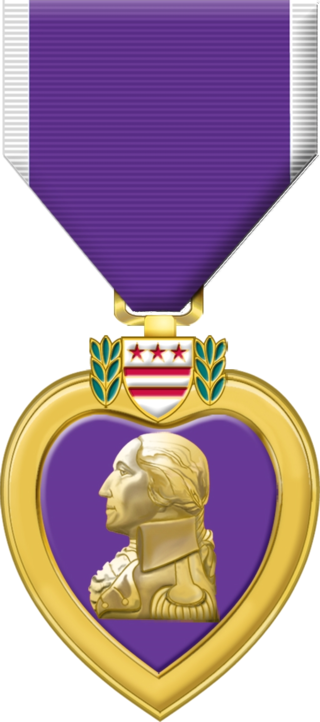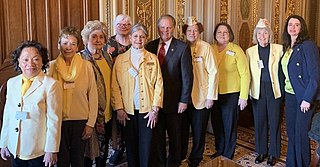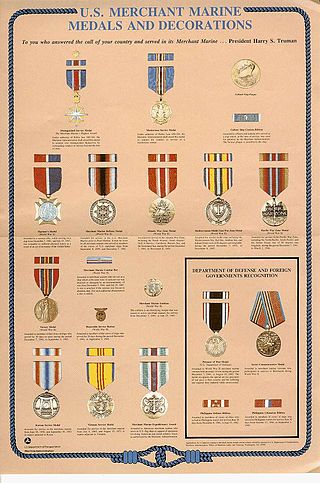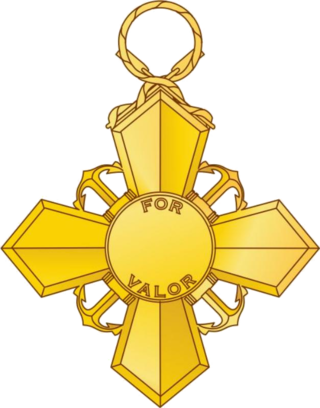
The Bronze Star Medal (BSM) is a United States Armed Forces decoration awarded to members of the United States Armed Forces for either heroic achievement, heroic service, meritorious achievement, or meritorious service in a combat zone.

The Legion of Merit (LOM) is a military award of the United States Armed Forces that is given for exceptionally meritorious conduct in the performance of outstanding services and achievements. The decoration is issued to members of the eight uniformed services of the United States as well as to military and political figures of foreign governments.

The Purple Heart (PH) is a United States military decoration awarded in the name of the president to those wounded or killed while serving, on or after 5 April 1917, with the U.S. military. With its forerunner, the Badge of Military Merit, which took the form of a heart made of purple cloth, the Purple Heart is the oldest military award still given to U.S. military members. The National Purple Heart Hall of Honor is located in New Windsor, New York.

American Gold Star Mothers, Inc. (AGSM), is a private nonprofit organization of American mothers who lost sons or daughters in service of the United States Armed Forces. It was originally formed in 1928 for mothers of those lost in World War I, and it holds a congressional charter under Title 36 § 211 of the United States Code. Its name came from the custom of families of servicemen hanging a banner called a service flag in the windows of their homes. The service flag had a star for each family member in the Armed Forces. Living servicemen were represented by a blue star, and those who had lost their lives in combat were represented by a gold star.

The Prisoner of War Medal is a military award of the United States Armed Forces which was authorized by Congress and signed into law by President Ronald Reagan on 8 November 1985. The United States Code citation for the POW Medal statute is 10 U.S.C. § 1128.

A declaration of war is a formal declaration issued by a national government indicating that a state of war exists between that nation and another. A document by the Federation of American Scientists gives an extensive listing and summary of statutes which are automatically engaged upon the United States declaring war.
Gold Star mothers are women entitled to display a gold star on a service flag as the mother, stepmother, adoptive mother or foster mother of a United States Armed Forces member that died while engaged in action against an enemy recognized by the Secretary of Defense.
The World War I Victory Medal was a United States service medal designed by James Earle Fraser of New York City under the direction of the Commission of Fine Arts.

A service flag or service banner is a banner that family members of those serving in the United States Armed Forces can display. The flag or banner is officially defined as a white field with a red border, with a blue star for each family member serving in the Armed Forces of the United States during any period of war or hostilities. A gold star represents a family member who died during military operations, including those who died during World War I, World War II, or any subsequent period of armed hostilities in which the United States was engaged before July 1, 1958, and those who lost or lose their lives after June 30, 1958:
- while engaged in an action against an enemy of the United States;
- while engaged in military operations involving conflict with an opposing foreign force; or
- while serving with friendly foreign forces engaged in an armed conflict in which the United States is not a belligerent party against an opposing armed force;

The Gold Star Wives of America (Gold Star Spouses) (GSW) is a private nonprofit organization formed before the end of World War II that provides support for surviving spouses and children of those who lost their lives due to military service Armed Forces of the United States.
United States military seniority is the method by which the United States Armed Forces determines precedence among commissioned officers, in particular those who hold the same rank. Seniority is used to determine assignments, tactical commands, promotions and general courtesy. To a lesser extent, historical seniority is used to recognize status of honor given to early United States military leaders such as inaugural holders of certain ranks or those officers who served as leadership during major wars and armed conflicts.
Enemy combatant is a term for a person who, either lawfully or unlawfully, engages in hostilities for the other side in an armed conflict, used by the U.S. government and media during the War on terror. Usually enemy combatants are members of the armed forces of the state with which another state is at war. In the case of a civil war or an insurrection "state" may be replaced by the more general term "party to the conflict".
A rosette is a small, circular device that is typically presented with a medal. The rosettes are either worn on the medal to denote a higher rank, or for situations where wearing the medal is deemed inappropriate, such as on a suit. Rosettes are issued in nations such as Belgium, France, Italy and Japan. Rosettes are also sometimes called bowknots, due to their shape. Moreover, a large rosette is sometimes pinned onto the ribbon which suspends a medal, typically the Officer 's badge of certain orders of chivalry.

Awards and decorations of the United States Merchant Marine are civilian decorations of the United States which are issued to the members of the United States Merchant Marine for a variety of duties both in peace and war. Originally authorized to be issued by the War Shipping Administration of the World War II era, these awards were later issued by the Maritime Commission and are currently issued by the Department of Transportation's Martitime Administration.

Blue Star Mothers of America, Inc. (BSMA), is a private nonprofit organization in the United States that provides support for mothers who have sons or daughters in active service in the U.S. Armed Forces. It was originally formed during World War II. The name came from the custom of families of servicemen hanging a banner called a Service Flag in a window of their homes. The Service Flag had a star for each family member in the military. Living servicemen were represented by a Blue Star and those who had lost their lives were represented by a Gold Star. Until 2011, membership in the Blue Star Mothers was open to any woman living in America who has a son or daughter in the United States Armed Forces, or who has had a son or daughter in the U.S. Armed Forces who was honorably discharged.
The National Defense Authorization Act (NDAA) for Fiscal Year 2012 is a United States federal law which, among other things, specified the budget and expenditures of the United States Department of Defense. The bill passed the U.S. House on December 14, 2011 and passed the U.S. Senate on December 15, 2011. It was signed into law on December 31, 2011 by President Barack Obama.

The Distinguished Warfare Medal was a planned United States military decoration announced by former U.S. Secretary of Defense Leon Panetta on 13 February 2013. It would have been the first U.S. combat-related award to be created since the Bronze Star Medal in 1944. The blue, red and white-ribboned medal was to be awarded to individuals for "extraordinary achievement" related to a military operation occurring after 11 September 2001. It was intended to recognize military achievement in cyberwarfare or combat drone operations for actions that did not include valor in combat.

The Coast Guard Cross (CGC) is the United States Coast Guard's second highest military decoration for Coast Guardsmen who distinguish themselves extraordinary heroism in combat with an armed enemy force. Established by Act of Congress on 15 October 2010, it is intended to recognize members of the United States Coast Guard for extraordinary heroism in action. Coast Guardsmen serving under the Department of the Navy would be eligible for the Navy Cross. This medal, though approved, has not yet been awarded. By virtue of having never been awarded, it is the rarest United States military award.
Service lapel button may refer to:

The Medal of Honor (MOH) is the United States Armed Forces' highest military decoration and is awarded to recognize American soldiers, sailors, marines, airmen, guardians and coast guardsmen who have distinguished themselves by acts of valor. The medal is normally awarded by the President of the United States and is presented "in the name of the United States Congress."












